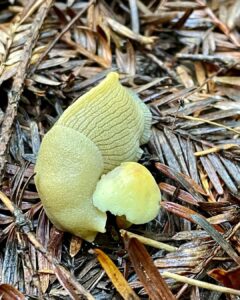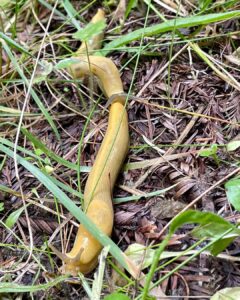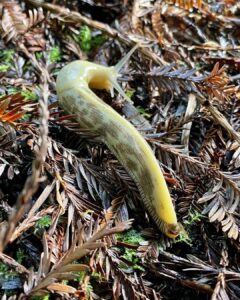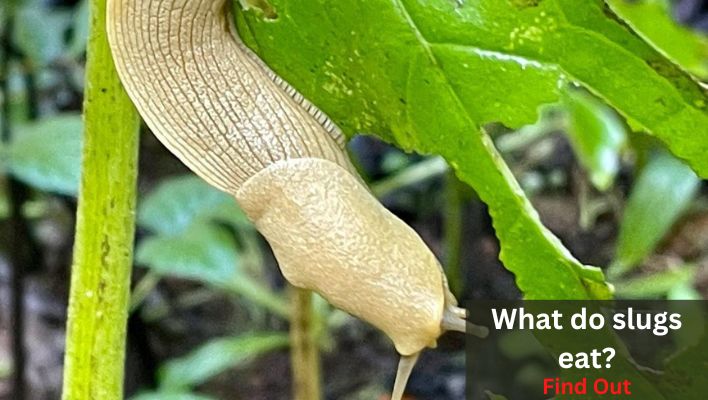Many of us are familiar with slugs eating our garden plants. But what do slugs eat when they are not eating our garden plants?
If you have ever had slugs crawl up your leg or come into your garden, you will know how frustrating they can be. The secret to slug control is knowing their behavior, such as what they eat, what they like, and so on. Knowing this will effectively help with the control of these pesky pests.
As you probably already know, slugs eat plants, which is generally not good if your garden is full of plants. Also, slugs love decaying plant matter, such as old leaves, logs, and branches.
But what do slugs eat when they are not eating plants? Slugs eat a lot more than just plant matter. They can feast on carrion from other animals, including other slugs.
There are hundreds of different types of slugs found all over the world. They come in various colors and have different characteristics, but these two facts remain the same: they eat and live on land. In this article, we’ll take a look at what slugs eat.
What slugs eat
Slugs are one of the few gastropods that can digest their poop. For this reason, it’s not surprising that they can eat almost anything. In fact, slugs are so versatile that they’ll even eat other dead slugs to satisfy their hunger.

Slug eating habits are quite varied. Some slugs eat algae, while others eat decaying leaves and wood, thus enhancing the nutrient of your soil. Not all slugs are considered pests. However, some of these creatures tend to be omnivorous and will eat just about anything they can find.
Slugs are usually herbivorous, meaning that they only eat plants. However, some slugs eat insects and dead animals, such as worms or other slugs.
The most common foods slugs eat include:
- Fruits and vegetables
- Fungi, such as mushrooms, lichen, and mosses
- A wide range of insects, including flies, spiders, and beetles
- Corpses of other slugs or snails and worms
North America’s most common slug is the house slug (Deroceras reticulatum). These slugs look like miniature versions of an earthworm and live in gardens and in the ground, where they find shelter from predators by burrowing into the soil.
Fruits and vegetables Slugs eat.
They eat hostas, tomatoes, carrot tops, lettuce plants, pansies, strawberries, grape leaves, strawberries, peaches, apples, carrots, and lettuce are some of their favorite fruit.
Slugs have difficulty digesting tough, fibrous plants like lettuce, so they’ll often slurp up any soft fruits or vegetables they can find in their environment.
They love strawberries, bananas, watermelon, other summer fruits, and green leafy vegetables like celery and lettuce. Slugs also like to munch on the roots of plants like carrots and potatoes growing in their garden beds.
Plants slugs, and snails hate
Most plants are slugs and snail-friendly, but there are some that are not. The type of plants that slugs and snails hate the most are succulents, cacti, and more. Succulents are thick leaves and stem that do not need much water—so they’re perfect for a drought-stricken garden.
Cacti are plants that live in the desert, so they don’t need much water either. They’re also usually easy to care for and easy to identify.

In addition to these three types of plants, slugs and snails also generally dislike roses and rosemary, as well as any other type of foliage that’s green on both sides (like palm trees). Here’s a list of the plants that slugs and snails hate:
- Eggplant (especially if it’s been treated with slug bait)
- Alliums (onion, garlic, chives, etc.)
- Berries (especially blackberries and raspberries)
- Azaleas
- Lettuce (but only if it’s been treated with slug bait)
- Hedgehogs
In general, slugs and snails hate plants that are:
- Soft or hairy.
- Dark green, red, or yellow.
- Full of water.
- Spiky (like cacti).
- Full of tiny holes like a sponge.
- Full of nooks and crannies that they can hide in.
How slugs hunt
If they eat other creatures, how do slugs hunt these creatures? Slugs have a lot of hunting skills. They can sense vibrations, smell chemicals in the air and even see colors. They track their prey by sensing changes in temperature and pressure. Slugs also use their sensitive snouts to detect the movement of their prey.
Most slugs hunt by sensing their prey’s vibrations. They have a special organ called a statocyst that helps them detect the vibrations of their prey. The statocyst is located on the slug’s head and can detect prey as small as a cricket or as large as a human. They can do this in several ways:
The first way is to sense the vibrations of the prey as they move. This could be through a long, sensitive tongue or other appendages sensitive to movement.
The second method of sensing vibrations involves detecting air currents caused by the prey’s movements. Slugs use these air currents to determine where their prey is to them.
A third method is using their antennae and other sensory organs to detect movement. This can also be done with a long, sensitive tongue or other appendages sensitive to motion or vibration.
In order to hunt, slugs use their sense of smell to find the scent of their prey, then move in for the kill. The slug’s mouth is on the underside of its body, and it can find its way around by using its antennae and tentacles to locate prey.
It then grabs hold with its tentacles and grabs its target with its mouth. If successful, it rips open the animal with its jaws before consuming it whole. Slugs also have eyes that are sensitive to light and movement, so they can also use them.

What attracts slugs?
Slugs are attracted to the smell of ripe fruit, and they may also be attracted to the smell of decaying vegetables. Slugs are also attracted to the smell of ammonia.
Also, slugs are attracted to dark areas with high humidity, such as gutters and water-absorbing surfaces, such as concrete or other porous materials. They also like to eat plants with high nitrogen content to ensure they are in good health. Here is a detailed guide to permanently remove slugs from your garden if you have an infestation.
When slugs eat
You’re probably wondering, “When do slugs eat?” The answer is all year round. They eat in the spring, summer, and fall. Slugs eat at night, during the day, or both. They eat during the day when they’re hungry and after dark when they’re more active.
Slugs eat during daylight hours is why you’ll often find them munching on your lawn in the early morning or late afternoon when the sun’s out but not too hot yet.
Slugs are omnivores, so they’ll eat whatever they can find, chew on (and sometimes even run around on). In the springtime, slugs tend to focus on foods like grasses and flowers (which makes sense—they’re naturally going to want growing food), but in the summertime, you’ll see them eating a lot more fruit than usual.
In the fall, they will likely be eating leaves or roots that have fallen off trees or plants. Some slugs feed on leaves; others prefer to snack on roots and stems. The main reason is that there’s more protein in some of these parts than in others.
How often do slugs eat
While slugs are known for their voracious eating habits, it doesn’t mean they eat all the time. Slugs will only eat when hungry, usually in the early morning and evening.
Some slugs are more likely than others to eat plants in your garden, but even within a species, there can be a range of feeding habits.
For example, the common blue-ringed slug eats mostly leaves from trees and shrubs, while the giant Pacific slug prefers soft plant parts (like flowers and foliage) over hard plant parts (like leaves).
Slugs like to eat at night when they are most active. They can be found under logs, rocks, boards, and soil during the day.
What leopard slugs eat
The most popular slug you’ll find in your garden is the leopard slug (Aplysia California), which is also known as the California sea hare.
Leopard slugs are omnivores, which means they eat both plants and some animals. Their diet depends on what they can find in their environment, but they’ll also eat other slugs if they’re hungry enough.

They usually eat plants and small animals, but they have been known to eat insects, fruit, and even plants that are unsuitable for eating. Leopard slugs may eat:
- Live prey: This includes insects and small spiders. They have even been known to eat worms.
- Dead prey: This includes dead insects and other small animals that are already dead.
- Plants: Leopard slugs love eating plants. They will happily munch down on grass, flowers, leaves, and even seeds from trees.
What banana slugs eat
Banana slugs eat plants. They are herbivores, and they feed on plant matter such as leaves, stems, and roots.
In the wild, banana slugs can be found under rocks or in other hiding places in tropical areas. They eat many plants, including fruit trees such as avocado, guava, apple, and mango. They may even eat toxic plants like morning glory vines.

Do slugs eat foxgloves?
No, slugs don’t eat foxgloves. Foxgloves are poisonous to slugs and too high-maintenance for them.
The reason why is that foxgloves are pretty much indigestible to slugs. They’re made of fibers and pithy material that would be hard for a slug to chew through.
And if you’ve ever seen a slug try to eat one of these plants, let’s say it doesn’t end well for the slug. So if you’re worried about them eating other plants or getting into your house, there’s good news: slugs hate foxgloves.
Slugs don’t want anything to do with foxgloves because they’re highly poisonous to slugs—even more so than other plants. So if you think you have a slug problem right now, remember that these nasty little buggers can’t stand foxgloves (and, by extension, other invasive plants such as privet).
Do slugs like geraniums?
Yes, slugs like geranium, but they do not eat them. They will, however, hide behind their broad leaves during the days before heading out. Geranium also grows well in shady spots, which slugs love, but they will not feed on its leaves.
